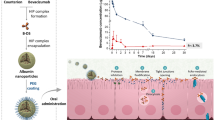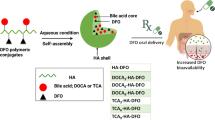Summary
By equilibrium dialysis of human plasma it has been shown that the binding of pentobarbital and diphenylhydantoin to plasma proteins is decreased in uraemic patients (46 and 74 per cent bound, respectively) compared to healthy volunteers (61 and 88 per cent bound). The degree of binding of pentobarbital was significantly correlated with that of diphenylhydantoin and amobarbital, which suggests similarity of their binding sites. Appreciable proportions of the drugs were found in blood cells both in healthy and uraemic subjects. As expected, the distribution of drugs in whole blood was different in the uraemics from healthy subjects, because of the decreased plasma protein binding and the lowered red cell count in uraemia. Analysis of the data showed that the ratio between the concentrations in blood cells and plasma water in uraemic patients was not significantly different from that in healthy subjects.
Similar content being viewed by others
References
Reidenberg, M.M., Odar-Cederlöf, I., von Bahr, C., Borga, O., Sjöqvist, F.: Protein binding of diphenylhydantoin and desmethylimipramine in plasma from patients with poor renal function. New. Engl. J. Med.285 264–267 (1971)
Anton, A.H., Corey, W.T.: Interindividual differences in the protein binding of sulfonamides: The effect of disease and drugs. Acta pharmacol. (Kbh.)29 Suppl. 3, 134–151 (1971)
Shoeman, D.W., Azarnoff, O.L.: The alteration of plasma proteins in uremia as reflected in their ability to bind digitoxin and diphenylhydantoin. Pharmacology (Basel)7 169–177 (1972)
Ehrnebo, M., Agurell, S., Boréus, L.O., Gordon, E. Lönroth, U.: Binding of pentazocine to blood cells and plasma proteins in man. Clin. Pharmacol. Ther.16 424–429 (1974)
Witzgall, H., Boyens, H.: Die Bedeutung der Bindung an Albumin, Körperzellen und Bakterien für Pharmakodynamik und Wirkung von Arzenistoffen. Arch. int. Pharmacodyn.148 511–535 (1964)
Mc Arthur, J.N., Dawkins, P.O., Smith, M.J.H.: The binding of indomethacin, salicylate and phenobarbitone to human whole blood in vitro. J. Pharm. Pharmacol.23 32–36 (1971)
v. Bock, H.E., Löhr, G.W., Waller, H.D.: Beitrag zur Pathogenese renaler Anämien. Schweiz. med. Wschr.40 1213–1232 (1962)
Mancini, G., Carbonara, A.O., Heremans, J.F.: Immunochemical quantitation of antigens by single radial immuno diffusion. Immunochemistry2 235–254 (1965)
Heinegård, D., Tiderström, G.: Determination of serum creatinine by direct colourimetric method. Clin. chim. Acta43 305–310 (1973)
Ohlsson, W.: Eine einfache und für klinische Zwecke geeignete Micromethode zur Bestimmung des Harnstoffstickstoffs (UrN)+ im Blute durch Ureasebehandlung und direkte Nesslerisierung. Acta physiol. scand.1 278–284 (1940)
Ehrnebo, M., Agurell, S., Jalling. B., Boréus, L.O.: Age differences in drug binding by plasma proteins: Studies on human foetuses, neonates and adults. Europ. J. clin. Pharmacol.3 189–193 (1971)
Schanker, L.S., Johnson, J.M., Jeffrey, J.Y.: Rapid passage of organic anions into human red cells. Amer. J. Physiol.207 503–508 (1964)
Lunde, P.K.M., Rane, A., Yaffe, S.Y., Lund, L., Sjöqvist, F.: Plasma protein binding of diphenylhydantoin in man: Interaction with other drugs and the effect of temperature and plasma dilution. Clin. Pharmacol. Ther.11 846–855 (1970)
Nilsson, S.O., Ågren, A., Brånstad, J.O., Meresaar, U.: Complex formation between macromolecules and drugs. IX. The competition between two sulfa drugs and phenobarbital, pentobarbital or phenoxymethyl penicillin for binding sites on human serum albumin. Acta pharm. suecica10 455–468 (1973)
Erslev, A.: Erythropoietic function of the kidney. In: Physiology of the human kidney. ed. Wesson, L.G., pp. 521–534. New York: Grune & Stratton 1969
Eklund, S.G., Johansson, S.V., Strandberg, O.: Anemia in uremia. Acta med. scand.190 435–443 (1971)
Wind, M., Berliner, A., Stern, A.: The binding of phenothiazines to oxyhemoglobin A and S. Res. Comm. Chem. Pathol. Pharmacol.5 759–766 (1973)
Kwant, W.O., Seeman, P.: The membrane concentration of a local anesthetic (chlorpromazine). Biochim. biophys. Acta (Amst.)183 530–543 (1969)
Baker, G.F., Rogers, H.J.: Effects of psychotropic drugs on the erythrocyte permeability to glucose and ethylidene glucose. Biochem. Pharmacol.21 1871–1878 (1972)
Roth, S., Seeman, P.: All lipid-soluble anaesthetics protect red cell. Nature (New Biol.)231 284–5 (1971)
Williams, A.R.: The effect of bovine and human serum albumins on the mechanical properties of human erythrocyte membranes. Biochim. biophys. Acta (Amst.)307 58–64 (1973)
Borondy, P., Dill, W.A., Chang, T., Buchanan, R.A., Glazko, A.J.: Effect of protein binding on the distribution of 5,5-diphenylhydantoin between plasma and red cells. Ann. N.Y. Acad. Sci.226 82–87 (1973)
Odar-Cederlöf, I., Borgå, O.: Kinetics of diphenylhydantoin in uremic patients: Consequences of decreased plasma protein binding. Europ. J. clin. Pharmacol.7 31–38 (1974)
Dacie, J.V.: The haemolytic anaemias. Part. IV. London: J.E.A. Churchill Ltd., 1967
Balasubramaniam, K., Mawer, G.E., Pohl, J.E.F., Simons, P.J.G.: Impairment of cognitive function associated with hydroxyamylobarbitone accumulation in patients with renal insufficiency. Brit. J. Pharmacol.45 360–367 (1972)
Gibaldi, M., Nagashima, R., Levy, G.: Relationship between drug concentration in plasma or serum and amount of drug in the body. J. pharm. Sci.58 193–197 (1969)
Author information
Authors and Affiliations
Rights and permissions
About this article
Cite this article
Ehrnebo, M., Odar-Cederlöf, I. Binding of amobarbital, pentobarbital and diphenylhydantoin to blood cells and plasma proteins in healthy volunteers and uraemic patients. Eur J Clin Pharmacol 8, 445–453 (1975). https://doi.org/10.1007/BF00562320
Received:
Accepted:
Issue Date:
DOI: https://doi.org/10.1007/BF00562320




